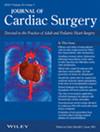Impact of valve in valve aortic valve implantation in valve choice decision making.
IF 1.3
4区 医学
Q3 CARDIAC & CARDIOVASCULAR SYSTEMS
引用次数: 0
Abstract
To the Editor, I read with interest the excellent study of Kim and his colleagues to compare the clinical outcome of long term survival in patients aged 50–69 years old who underwent isolated aortic valve replacement with mechanical versus bioprosthetic valves. The study showed no significant difference in cardiac mortality‐ free survival and long‐term survival rates between the two valves. Valves choice decision making was and still a constant dilemma since the adventure of those two types of valves. Eventually it is dependent on patient related factors and patient choice. Mechanical valves are associated with increase risk of anticoagulation related hemorrhage and thromboembolism. It also requires frequent coagulation monitoring and closer outpatient follow up. Degeneration and calcification causing valve dysfunction and requiring reoperation are the main concern with bioprosthesis. Currently, the swift advances in transcatheter procedures changed the future of cardiac surgery. Transcatheter aortic valve implantation and valve in valve aortic valve implantation are recently introduced interventional procedures and proved to be a reasonable therapeutic option for high risk and moderate risk patients avoiding resternotomy and comorbidities of surgical aortic valve replacement. These new interventional advances in catheter valve procedures affected the decisions making in valve choice and tilted the cuff and the scale in favor of bioprosthesis. Khaled E. Al‐Ebrahim FRCSC主动脉瓣植入术对瓣膜选择的影响。
本文章由计算机程序翻译,如有差异,请以英文原文为准。
求助全文
约1分钟内获得全文
求助全文
来源期刊
CiteScore
2.90
自引率
12.50%
发文量
976
审稿时长
3-8 weeks
期刊介绍:
Journal of Cardiac Surgery (JCS) is a peer-reviewed journal devoted to contemporary surgical treatment of cardiac disease. Renown for its detailed "how to" methods, JCS''s well-illustrated, concise technical articles, critical reviews and commentaries are highly valued by dedicated readers worldwide.
With Editor-in-Chief Harold Lazar, MD and an internationally prominent editorial board, JCS continues its 20-year history as an important professional resource. Editorial coverage includes biologic support, mechanical cardiac assist and/or replacement and surgical techniques, and features current material on topics such as OPCAB surgery, stented and stentless valves, endovascular stent placement, atrial fibrillation, transplantation, percutaneous valve repair/replacement, left ventricular restoration surgery, immunobiology, and bridges to transplant and recovery.
In addition, special sections (Images in Cardiac Surgery, Cardiac Regeneration) and historical reviews stimulate reader interest. The journal also routinely publishes proceedings of important international symposia in a timely manner.

 求助内容:
求助内容: 应助结果提醒方式:
应助结果提醒方式:


